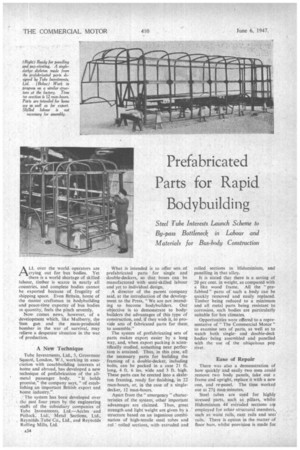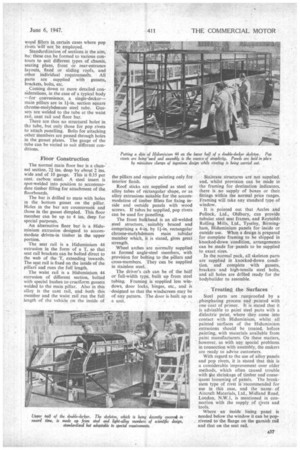Prefabricated Parts for Rapid Bodybuilding
Page 44

Page 47

If you've noticed an error in this article please click here to report it so we can fix it.
Steel Tube Interests Launch Scheme to By-pass Bottleneck in Labour and Materials for Bus-body Construction
ALL over the world operators are crying out for bus bodies. Yet there.is a world shortage of skilled labour, timber is scarce in nearly all countries, and complete bodies cannot he exported because of frugality of shipping space. Even Britain, home of the master craftsman in bodybuilding arid peace-time exporter of bus bodies in quantity, feels the pinch severely.
Now comes news, however, of a development which, like Mulberry, the Sten gun and the mass-produced bomber in the war of survival, may relieve a desperate situation in the war of production.
A New Technique
Tube Investments, Ltd., 3, Grosvenor Square, London, W.1, working in association with coachbuilding interests at home and abroad, has developed a new technique of prefabrication of the all metal passenger body. " It holds promise," the company says, " of establishing an important British export and home industry."
The system has been developed over are past four years by the engineering staffs of the subsidiary companies of Tube Investments, Ltd.—Accles and Pollock; Ltd:, Metal Sections, Ltd., Reynalds Tube Co., Ltd., anti Reynolds Rolling Mills, Ltd.
What is intended is to offer sets of prefabricated parts for single and double-deckers, so that buses can be manufactured with semi-skilled labour and yet to individual design. ,
. A director of the parent company said, at the introduction of the development to the Press, "We arc not intending to become bodybuilders. Our objective is to demonstrate to body:. builders the advantages of this type of construction, and, if they wish it, to provide sets of fabricated parts for them, to assemble."
The system of prefabricating sets of parts makes export easier by a long way, and, when export packing is scientifically studied, something near perfection is attained. Thus, in this case, all the necessary parts for building the framing of a double-decker, including bolts, can be packed in a case 21 ft. long, 4 ft. 6 ins, wide and 3 ft. high, These parts can be erected into a skeleton framing, ready for finishing, in 22 man-hours, or, in the case of a singledecker, 12 man-hours.
Apart from the " emergency" characteristics of the system, other important advantages are claimed. Thus, great strength and light weight are given by a structure based on an ingenious combination of high-tensile steel tubes and col : rolled sections, with extruded and rolled sections in Hiduminium, and panelling in that alloy.
It is stated that there is a saving of 20 per cent, in weight, as compared with a like wood frame. All the " prefabbed " parts of such a body can be quickly removed and easily replaced. Timber being reduced to a minimum and all metal parts being resistant to corrosion, such bodies are particularly suitable for hot climates.
Opportunities were offered to a representative of "The Commercial Motor" to examine sets of parts, as well as to watch both singleand double-deck bodies being assembled and panelled with the use of the ubiquitous pop rivet.
Ease of Repair There was also a demonstration of how quickly and easily two men could remove two body panels, take out a• frame and upright, replace it with a new one, and re-panel. The time worked out at 27i mart-minutes.
Steel tubes are used for highly stressed parts, such as pillars, whilst Hiduminium 44 'exh2u.ded sections arr employed for other structural member$, such as waist rails, cant rails and seat' rails. There is option in the matter of floor bars, whilst provision is made for
wood Qllers ia certain cases where pop rivets Will not be employed.
Standardization of sections is the aim, bu these can be formed to various contours to suit different types of chassis, seating plans, front or rear-entrance layouts, fixed or sliding roofs, and other individual requiremetits. All parts are supplied with gussets, brackets, bolts, etc.
Coming down to more detailed considerations, in the case of a typical body —for convenience, a single-decker—
main pillars are in section square chrome-molybdenum steel tube. Gussets are welded to the tube at the waist rail, cant rail and floor bar.
There are thus no structural hole in tha tube, but only those for pop rivets to attach panelling. Bolts for attaching other members are passed through holes in the gusset plates. The gauge of the tube can be varied to suit different conditions.
Floor Construction The normal main floor bar is a chan-' nel section, 21 ins, deep by about 2'ins. wide and of 10 gauge. This is 0.35 per cent. carbon steel. A steel insert is spot-welded into position to accommodate timber filling for attachment of the floorboards.
The bar is drilled to mate with holes in the bottom gusset on the pillar. Holes in the bar are countersunk and those in the gusset dimpled. This floor member can be up to 4 ins, deep for special purposes.
An alternative floor bar is a Hiduminium extrusion designed to accommodate driven-in timber in the upper portion.
The seat rail is a Hiduminium 44 extrusion in the form of a T, so that seat rail brackets can be bolted direct to the web of the T, extending inwards. The seat rail is fixed on the inside of the pillari and runs the full length.
The waist rail is a Hidurninium 44 extrusion of different section, bolted with special bushes to cruciform gussets welded to the main pillar. Also in this alloy is the cant rail, and both this member and the waist rail run the full length of the vehicle on the inside of the pillars and require painting only for interior finish.
Roof sticks are supplied as steel or alloy tubes of rectangular shape, or as alloy extrusions suitable for the accommodation of timber fillets for fixing inside and outside panels with wood screws. If tubes be supplied, pop rivets can be used for panelling.
The front bulkhead is an all-welded steel structure, suitably braced and comprising a 4-in., by rectangular chrome-molybdenum main tubular member which, it is stated, gives great strength.
Wheel arches are normally supplied as formed angle-steel members, with provision for bolting to the pillars and cross-members. They can be supplied in stainless steel.
The driver's cab can be of the half or full-width type, built up from steel tubing, Framing is supplied less windows, door locks, hinges, etc., and is designed so that the windscreen may be of any pattern. The door is built up as a unit. Staircase structures are not supplied, and, whilst provision can be made in the framing for destination indicators, there is no supply of boxes or their fittings within the normal price ranges. Framing will take any standard type of window.
It is pointed out that Accles and Pollock, Ltd., Oldbury, can provide tubular steel seat frames, and Reynolds Rolling Mills, Ltd., Tyseley, Birmingham, Hiduminium panels for inside or outside use. When a design is prepared for complete framing to be shipped in knocked-down condition, arrangements can be made for panels to be supplied to exact sizes.
In the normal pack, all skeleton parts are supplied in knocked-down condition, and complete with gussets, brackets and high-tensile steel bolts, and all holes are drilled ready for the bodybuilder to assemble.
Treating the Surfaces
Steel parts are rustproof ed by a phosphating process and painted with one coat of primer. It is stated that it is advisable to paint steel parts with a dielectric paint, where they come into contact with Hiduminiurn, whilst all painted surfaces of the Hiduminiem extrusions should be treated, before painting, with materials available from paint manufacturers. On these matters, however, as with any special problems in connection with assembly, the makers are ready to advise customers.
With regard to the use of alloy panels and pop rivets, it is stated that this is a considerable improvement over older methods, which often caused trouble with ttie shrinkage of timber and consequent loosening of panels. The breakstem type of rivet is recommended for use in this case, and the name.. of Aircraft Materials, Ltd., Midland Road, London, N.W.1, is mentioned in connection with the supply of rivets and tools.
Where an inside lining panel is needed below the window it can be popriveted to-the flange on the garnish rail and that on the seat rail.












































































